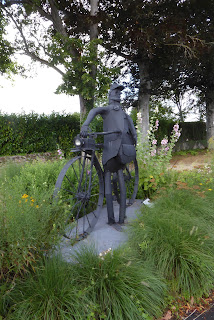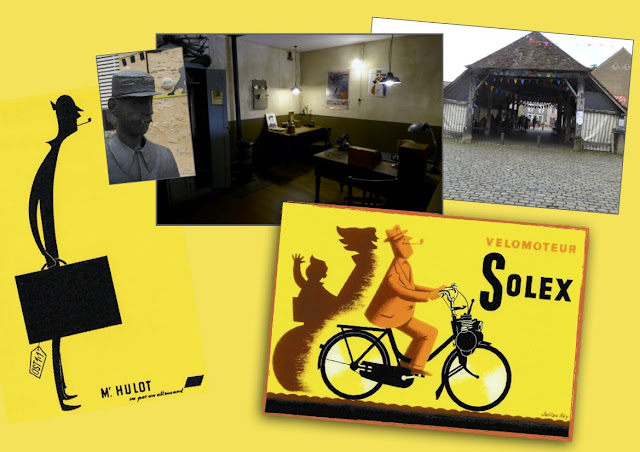Probably only the most attuned Jacques Tati fans can recite the locations where those few classic films were shot. We've already ticked off the most famous of these: St Marc, where Mr Hulot's Holiday was filmed (see pharesighted post 48 concerning grand charpentier). The place is very proud of its assocation with Tati and it still exudes traces of the sleepy holiday atmosphere the film captures.
So when we were passing through Sainte-Sévère-sur-Indre and a poster for Jour de Fête was espied, we thought at first it was just a local showing of Tati's 1947 film, but then we realised (or Mme Melling did, she is notably quick on the uptake, compared to your author) that this sleepy town was the place where it was mostly shot. A full brake application and a quick about turn was called for and duly executed: firstly, to examine and take snaps of a roadside iron rendition of a postman (Tati's character in the film) secondly to get back to the market square…… this is it! This is the place! Look, it's hardly changed.
Sainte-Sévère-sur-Indre is smaller than Sablet but has several more distinguished buildings including the 15th century gatehouse on the town square, which formed the backdrop for much of Jour de Fête, along with the classic temple style town hall, you could hardly call it a mairie. There is also a medieval market hall (picture below); on our visit it was hosting an exhibition of political cartoons. The seats set out in the square I think might have been there for an annual screening of the film indicated by the roadside publicity, while the tourist office doubles up as a Tati shrine and museum. Not sure:we didn't ask, but I like to think so. Post cards, posters, books, dvds etc, that sort of thing. Open. even. The tourist office includes a reconstruction of the post office interior in the film, complete with a fine set of vintage telephones (sadly closed due to the covid thing). There's a fine rendition of the Tati postman in bronze outside but I preferred the painted cut out in the doorway, even though, obvs, the film was made in black and white.
Truth is, I haven't seen Jour de Fête in some years… and not surprisingly, given its vintage, one might be slightly underwhelmed by the early JT slapstick humour, so much more refined in Vacances de Mr Hulot . Released in 1947, you'd expect Jour de Fête to be a bit creaky, what with the recent ending of WW2, but fillum buffs and historians rate it highly… a bit like m'good self in fact: similarly 'released' in 1947, in black-&-white, to critical acclaim, a bit dated now (although now in colour) even a bit creaky – but a classic, rated highly by those in the know………
…… just who am I kidding?




